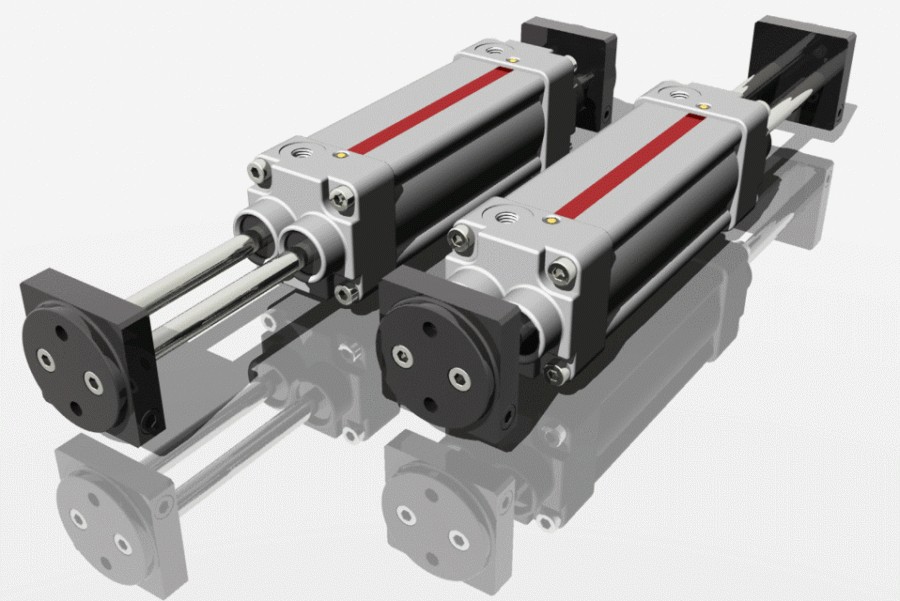Nov 20, 2025
Cylinder air consumption refers to the amount of compressed air a pneumatic cylinder uses to complete one action.(For double-acting cylinders, this means one full extend-and-retract cycle.For single-acting cylinders, it refers to the air used in the powered direction only.)Air consumption may also refer to the total volume of compressed air used over a period of time.
The compressed air consumed by the cylinder is supplied directly by the air compressor. Since the compressor's operation has a direct impact on energy usage, operating costs, and production capacity, understanding cylinder air consumption accurately is essential. It plays a critical role in selecting the right air compressor, choosing appropriate sizes for piping, valves, filters, and other pneumatic components, and optimizing system energy efficiency.
In addition, calculating air consumption helps ensure stable cylinder motion, maintain production cycle times, reserve capacity for future system expansion, and identify issues such as leakage and maintenance needs.
Let us remember the formula first: V=π×(D/2)²×L
There are two direct aspects affecting cylinder air consumption,and two indirect factors: compressor air pressure and frequency.
The piston stroke length is a direct influencing factor(L).Air consumption is positively correlated with stroke length,the longer the piston stroke, the larger the volume of air pushed per stroke.
The cylinder diameter is also a direct influencing factor.Air consumption is positively correlated with the square of the cylinder diameter,the larger the cylinder diameter, the larger the piston area, and the larger the volume of air required for each stroke.
Conclusion: Increasing the cylinder diameter → Significantly increases air consumption per stroke.
Air consumption is positively correlated with operating pressure (for the same cylinder bore and stroke, a high-pressure system consumes more air).The higher the pressure, the greater the density of compressed air required to push the piston per stroke.
Note: Although high-pressure air provides greater thrust, it consumes more compressed air, potentially reducing efficiency.
Air consumption is positively correlated with frequency.The more times a cylinder reciprocates, the greater the total air consumption per unit time.
Conclusion: The more frequently and faster the piston rod reciprocates, the more air the cylinder consumes.
We'll use a practical example to directly calculate the amount of compressed air used under different circumstances.
Formula: V = π × (2D)² × L
Where:
V = Gas volume required per stroke (m³ or L)
D = Cylinder inner diameter / Cylinder bore (meters or millimeters)
L = Piston stroke (meters or millimeters)
Example Parameters (L → m³ → SCFM)
Cylinder bore: D = 32 mm = 0.032 m
Stroke: L = 100 mm = 0.1 m
Working pressure: P = 6 bar
This experiment uses a double-acting cylinder
V = π × (0.032/2)² × 0.1
V = 3.1416 × 0.016² × 0.1
V = 3.1416 × 0.000256 × 0.1
V = 8.042 × 10⁻⁵ m³/stroke ≈ 80.4 mL/stroke
Vtotal=2×8.042×10−5=1.608×10−4 m³/cycle ≈ 161 mL/cycle
Step 3: Convert to SCFM (Standard Cubic Feet per Minute)
1 m³ = 35.3147 ft³
VSCF=1.608×10−4×35.3147≈0.00568 ft³/cycle
If the cylinder frequency is 60 cycles/minute:
Air consumption = 0.00568×60≈0.341 SCFM
Summary: The air consumption of a cylinder depends on several factors, such as the cylinder bore, stroke, cylinder type (single-acting/double-acting), and operating frequency. Using formulas can help engineers estimate air consumption, select a suitable air compressor, and optimize system efficiency.
However, the data may not necessarily reflect the actual response of the cylinder; theoretical values and actual conditions may differ depending on the following factors.
Cushioning
Presence or absence of piston rod
System pressure fluctuations
Pipeline leakage and frictional losses
Optimize stroke length and stroke count
Use appropriate cylinder bore
Adjust working pressure
Install high-efficiency cylinders (e.g., low-friction, magnetically detected)
Inspect lines and fittings to prevent leaks
You May Interest In

Nov 22, 2025 Blog
How to adjust pneumatic cylinder speed?
Nov 21, 2025 Blog
How does a pneumatic air cylinder work?
Nov 15, 2025 Blog
How long do pneumatic cylinders last?
Nov 14, 2025 Blog
How fast can a pneumatic cylinder move?Links: www.fescolo.com(Pneumatic)
FOKCA ©1998-2025 All Rights Reserved Sitemap